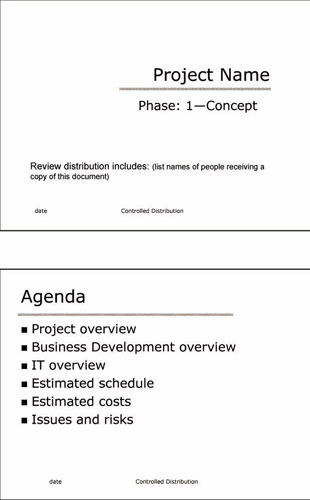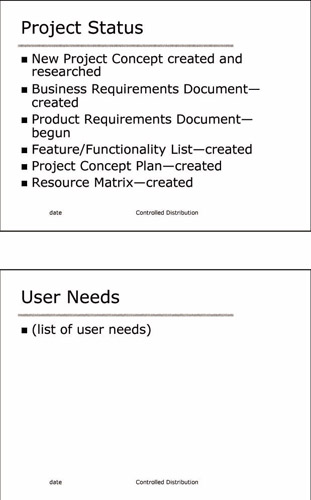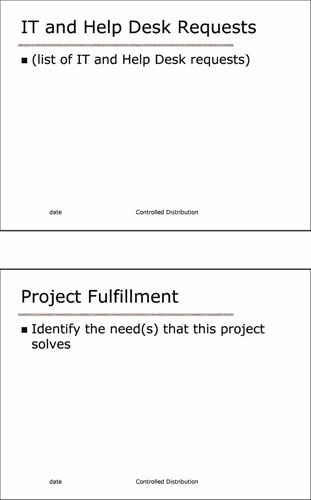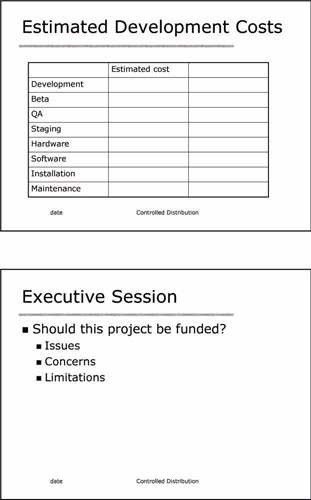1.8 The Project Concept Presentation
The Phase 1 lead presents a Project Concept Review to executive staff. The Phase 1 lead should bring a copy of the Business Requirements Document, the Feature/Functionality List, and the Project Concept Plan to the meeting, in case executives have questions regarding the project s estimates.
There should be a central location where all the final documents of the phase reviews are stored. For most companies this will be on a central server. The simplest and most effective method of running phase reviews is to create a standard boilerplate presentation that can be filled in by the Phase 1 lead and the Project Manager. By standardizing the phase presentations, confusion is minimized, the Phase 1 lead and the team understand what is expected of them, so information presented will be uniform from project to project. This will allow executive staff to judge fairly which projects should be funded . By centrally storing documents presented to executive staff, future team members are given a document trail by which they can understand what information went into decisions made before they became involved in the project.
At the end of each phase presentation, the executives will need to sign off on the presentation. This is necessary to confirm that executives actually had access to information presented.
It is important to understand the approval and funding process within the company. Funding of Phase 1 projects will depend on company procedures. Some companies have phase 1 presentations provided throughout the year. At budgeting time they review the Phase 1 projects that have been accepted and decide which get funding. Other companies have designated funds set aside for projects throughout the year. They can approve and fund a project at presentation time.
The Phase 1 presentation will include the pages shown in Figure 1.3.





Figure 1.3: Project Concept Presentation
Page 1: Cover Page. This document should be for controlled distribution and list the names of all the people attending and receiving the handout. The cover page should have the project name , the phase, and the date.
Page 2: Agenda. List what will be presented, the team member who will be presenting the item, and the time allotted for the presentation. Agenda items for a Phase 1 review may be: introduction, Business Development overview, IT overview, estimated schedule, estimated costs, issues and risks.
Page 3: Project Status. Review the items that have been created or completed in Phase 1.
For example:
New Project Concept created and researched
-
Business Requirements Document ”created
-
Product Requirements Document ”begun
-
Feature/Functionality List ”created
-
Project Concept Plan ”created
-
Resource Matrix ”created
Page 4: List of user needs.
Page 5: List of IT and Help Desk requests .
Page 6: Identify the need(s) that this project solves .
Page 7: Provide the Resource Matrix.
Page 8: List the proposed features and functionality.
Page 9: Show the estimated development costs.
-
Development cost
-
Beta, QA, and staging costs
-
Hardware costs
-
Software costs
-
Installation and support costs
-
Estimated yearly maintenance costs
-
Hardware/software
-
People costs
-
Page 10: Executive Session.
At the end of this session there will be an Executive Sign-Off (see Figure 1.4).

Figure 1.4: Executive Sign-Off Form
1.8 in a Nutshell
The Phase 1 lead should now have the information necessary to create a Project Concept presentation for the executive staff. A Project Concept presentation should be kept simple. Executive management needs to understand the general cost and scope of a project so they can decide whether to fund the project. Information to be presented:
-
Estimated development time
-
Estimated development cost
-
Expected feature list
-
Estimated availability
-
Resource Matrix
Tip Save all phase reviews in a central repository. This information will be beneficial for team members to review in later phases.
EAN: N/A
Pages: 105